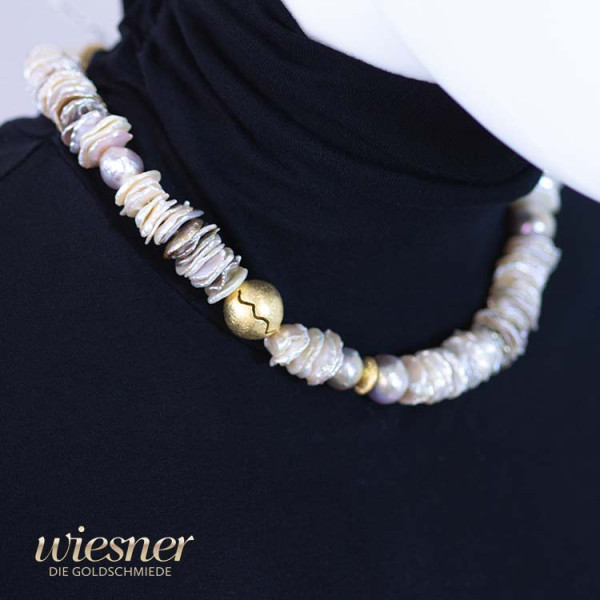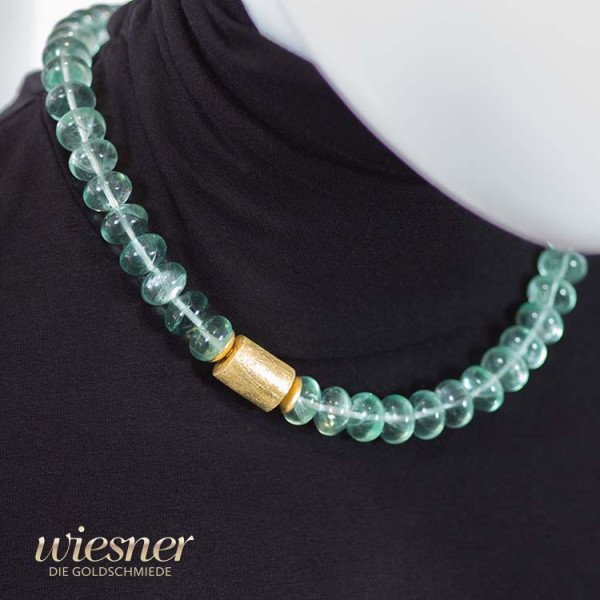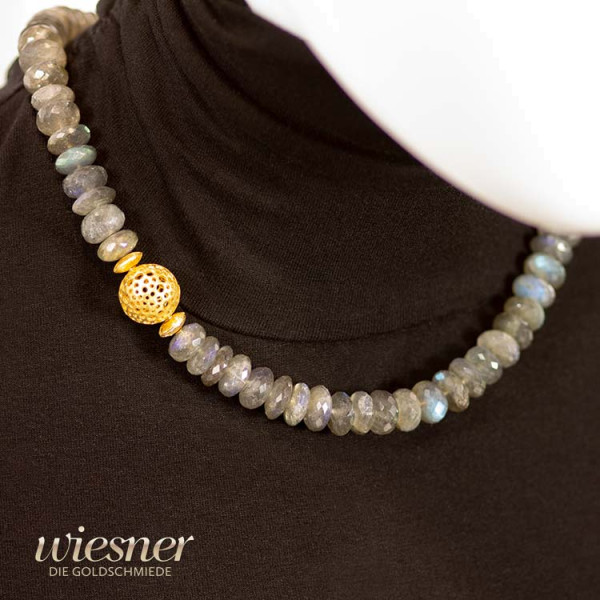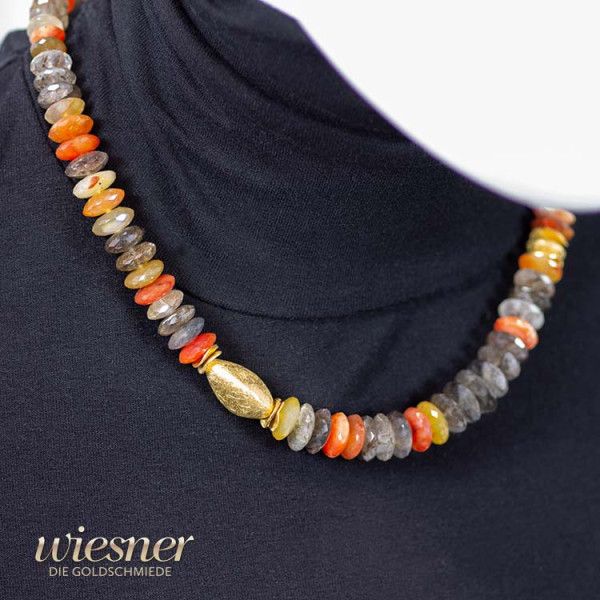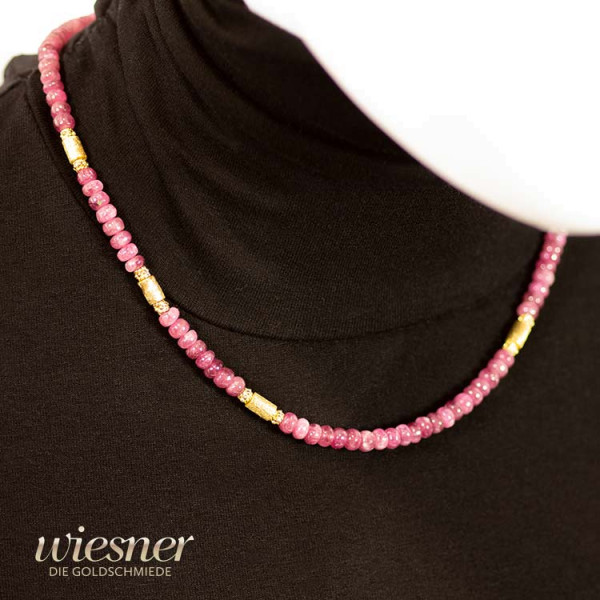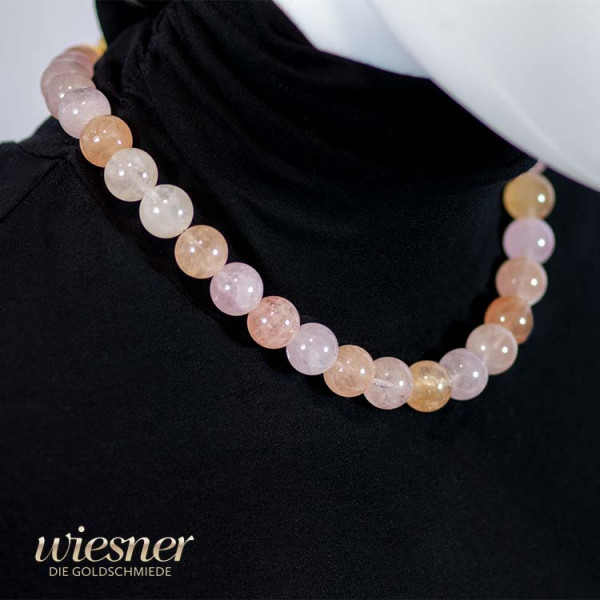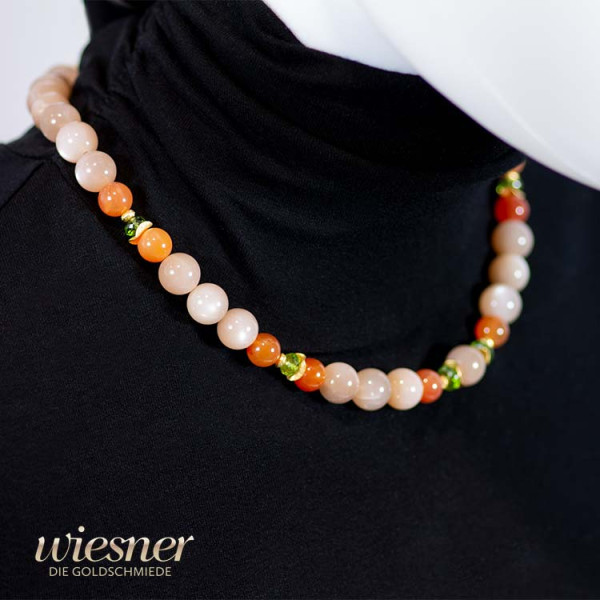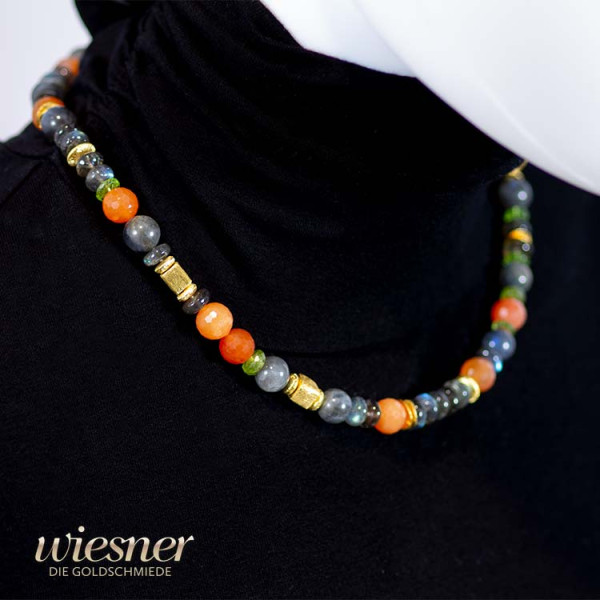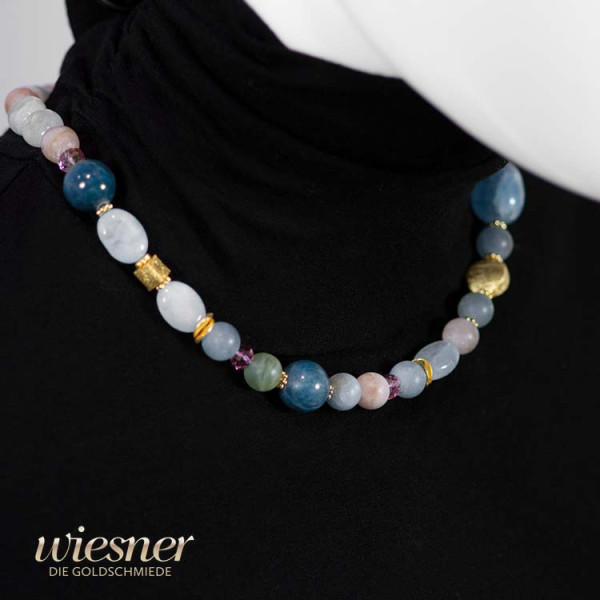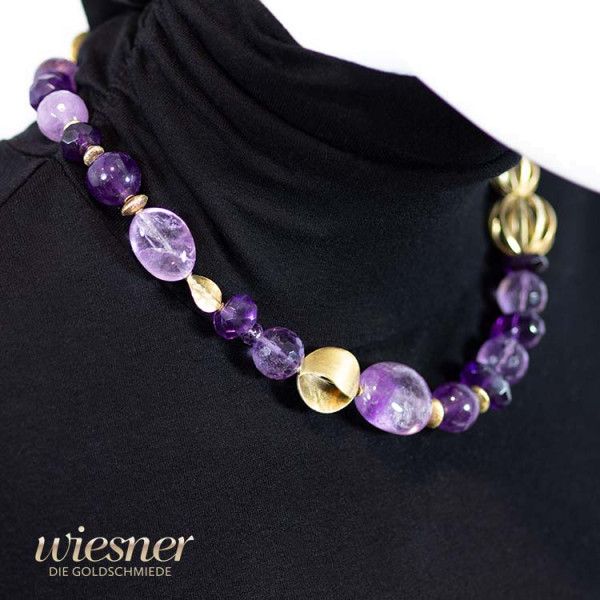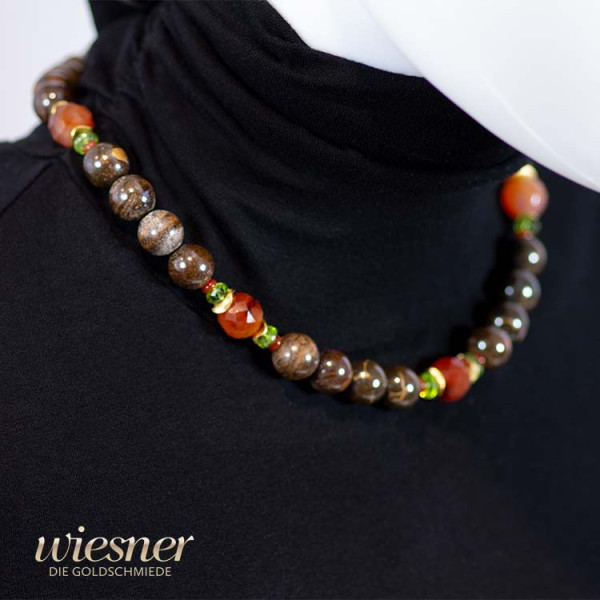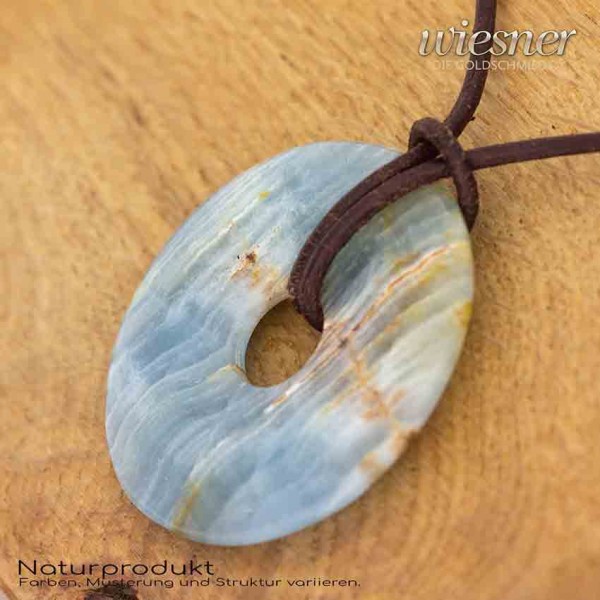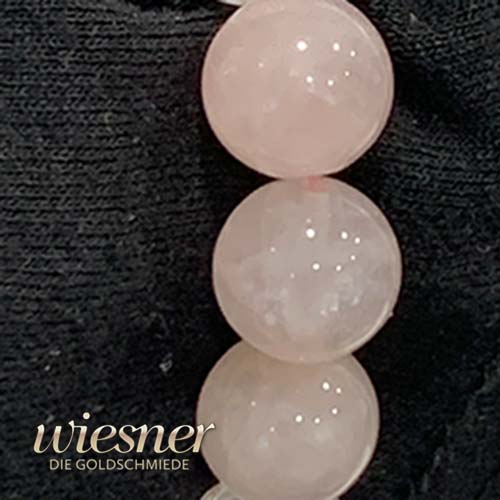Informative encyclopedia on the various gemstones used in jewelry
- Aquamarine as a gemstone
- Agate, the gemstone
- Amethyst
- Aragonite - harmony and stability
- Aventurine
- Amber
- Rock crystal
- Beryl - precious beryl
- Citrine
- Calcedony
- Chrysoprase
- Diamond
- Garnet
- Hematite
- Jade
- Carnelian - gemstone of vitality
- Coral
- Lapis lazuli
- Malachite
- Opal
- Smoky quartz
- Ruby
- Rose quartz - gemstone of love
- Sapphire
- Sonalite
- Emerald
- Schorl - energetic protective stone
- Topaz
- Turquoise
- Tourmaline
- Zircon
Gemstones | Facts, myths and historical backgrounds.
In this small encyclopaedia we try to provide some background knowledge, historical facts and myths about the individual gemstones for the interested reader. We hope you enjoy reading, browsing and smiling.
Aquamarine:
Aquamarine is a gemstone from the beryl group and has a Mohs hardness of 8, making it the second hardest stone after diamond. The color spectrum of aquamarine ranges from a light blue to a strong dark blue. Aquamarine is also available in a blue-green color, but this is not particularly popular. The color of these stones can be changed to a beautiful blue by firing them, i.e. heating them to 400 to 450° C. This method is often used today. This method is used very often today, stones that have this color from the beginning are rare and therefore very expensive. The most important locations are Brazil, Madagascar, South Africa, the Urals and the USA. The most beautiful aquamarines with the name Santa Maria come from the mine of the same name in Brazil and have an intense clear blue color. As the natural crystals are long and columnar, aquamarines are usually cut long and rectangular. Very popular cuts are: staircase cut, baguette cut, pendeloque, navette or oval cut. in 1910, the largest gem-quality aquamarine was found in the Gerais mine in Brazil. It weighed approx. 110 kg, was 48 cm long and had a diameter of approx. 40 cm. Gemstones with a total weight of over 100,000ct (1ct = 0.2 grams) were cut from this stone.
Agate - gemstone
Agate has a special position among gemstones, on the one hand because it has given its name to a unique industry with its center in Idar-Oberstein, on the other hand it is one of the few gemstones that are not only used for jewelry purposes but also for making bowls, handles of letter openers, knives and forks. Agate is available in many variations. During the formation of agate, individual layers of bands are formed; these bands can be of different colors. The colors of agate range from delicate to strong, especially from pink to red to brownish. These agates used to be found mainly in Germany in the Idar-Oberstein area. These agates could not be dyed and mining was discontinued. The agates found in South America usually have an unattractive grey color without markings. To give these stones their beauty, they are dyed. In the Middle East, agate was already being processed into rings, vessels and gems 3000 years ago. Today, agate is used more for decorative purposes such as agate eggs or to decorate the lids of small jars. For jewelry purposes, it is mostly used as layers for the production of gems.
Amethyst:
It takes its name from the Greek and means counteracting intoxication, so in ancient times it was regarded as protection against drunkenness. Of the quartz group, amethyst is the most sought-after. The color of amethyst ranges from a delicate light violet, almost pink, to a very strong dark violet. The dark purple stones are the most sought-after and most expensive. If the amethyst is fired at temperatures between 470 and 750°C, light yellow, reddish-brown, green or colorless varieties are obtained. Even daylight can cause some amethysts to lose their color or even become almost colorless. However, the original color can be restored by radium radiation. For this reason, amethysts should not be worn when sunbathing. Amethyst is mainly found in Brazil, Burma, Mexico, Madagascar, Zambia, Sri Lanka and Russia.
Aragonite - mythology and history
In the 18th century, the German mineralogist Abraham Gottlob Werner (1749 - 1817) named the gemstone after its presumed occurrence in Aragon. Apparently the stone also had a hexagonal crystal shape, which led to the name Arragonian apatite. However, after it was proven that the stone did not consist of calcium phosphate but of calcium carbonate, it was first renamed Arragonian calcite and then "Arragon". it was not until 1797 that it was given the name arragonite, although the term was still written with a double "r" at the time.
This name also remained controversial, as aragonite was not only found in Aragon/Spain, but also in Germany and France. Nevertheless, its name has not changed to this day. In the trade, the gemstone is also known as oceanite in addition to blue aragonite. The latter, because of its location in Argentina.
Gemstone aragonite as a "wellness stone"
The wellness sector attributes a stabilizing effect to aragonite. It promotes the implementation of plans and projects, stabilizes during busy times, promotes determination without losing the necessary flexibility and tolerance.
Aragonite - scientific characteristics
- The chemical formula of aragonite is CaCO3. It belongs to the mineral class of carbonates.
- It is formed in fissures and cavities in volcanoes.
- The blue color of aragonite is caused by copper inclusions. Colorless to brown areas are caused by additional inclusions of iron.
- The crystal system of aragonite is rhombic, its Mohs hardness is 3.5 to 4.
- It tends to have poor cleavage and breaks out in a conchoidal shape.
- Aragonite is found and mined in Spain, Austria, Mexico, Peru and China.
- Blue aragonite is mainly used to make decorative objects and jewelry. For example, our aragonite donut pendant here in the store
Aragonite in astrology
Astrology assigns the gemstone aragonite to the zodiac sign Sagittarius and the zodiac sign Aries as a harmonizing gemstone. It is said to help find the right balance. It is said to help the zodiac sign Aquarius achieve more stability.
Amber - the gemstone
Amber was formed up to 260 million years ago from viscous tree resin. Over the years, it became a solid substance. The name amber comes from the Low German word börnen, which means to burn, as amber burns. Amber is very rarely found in the clear quality that is commercially available; this clarity is achieved by so-called clear boiling in rapeseed oil. This flushes out the trapped liquids, air bubbles and plant parts and the stone becomes clear. These stones are usually made into necklaces. However, pieces of amber with trapped insects or larger plant parts are also sought after. If amber is rubbed against a cloth, it becomes electrically charged and then attracts dust particles or pieces of paper. Even in ancient times, people took advantage of this property and used a large piece of amber as a clothes brush. The world's largest find spot is in former East Prussia near Königsberg, now Kaliningrad. There are also large deposits of amber at the bottom of the Baltic Sea. After a strong storm, for example, you can take a walk along the beach on the island of Rügen and find one or two pieces of amber that have been washed up by the turbulent sea. Today, amber is mostly used to make necklaces, rings, pendants or brooches
Rock crystal:
It is often used as a diamond substitute or in fashion jewelry. Sometimes rock crystals weighing several tons are found, but these are usually of poor quality. Stones worth cutting that are used in the jewelry industry are relatively rare. The most important deposits of rock crystal are in the USA, Madagascar, Brazil and the Alps. Its name comes from the Greek krystallos - ice, rock crystal was thought to be eternally frozen.
Chrysoprase:
It is the most valuable stone in the chalcedony group. Its apple-green color makes it a very striking stone, and it reacts very sensitively to heat and light. If it is exposed to strong sunlight for a long time, the color can fade. It is sometimes possible to refresh the color by storing it in a damp cloth. The most important place where chrysoprase is found, Frankenstein, now Zabkowice in Poland, has been exploited since the 14th century. In the past, chrysoprase was also used as a decorative stone in interior design. It can be found in Sanscouci Palace and in the Chapel of St. Wenceslas in St. Vitus Cathedral in Prague. Today it is used for necklaces and is cut into cabochons for rings and pendants.
Chalcedony:
Chalcedony is the name of a group of stones including carnelian, jasper, heliotrope and chrysoprase, as well as the stone chalcedony. This is a bluish-white-grey stone that probably takes its name from an ancient city on the Bosporus. In contrast to shiny crystals such as rock crystal, it is usually waxy or matt. Today, it is mostly used as a material for cameos, ring stones, seal stones and stone necklaces. It has been used for a very long time and is therefore often found in antiques. Large pieces are also used to make columns, table tops and vases. Chalcedony can be found in Brazil, Namibia, Madagascar and India.
Citrine:
Citrine got its name from its yellow color, which resembles that of a lemon. Natural yellow citrines are relatively rare. Most of the stones on the market are burnt amethysts. From a temperature of approx. 470° C, the amethyst changes color to a light yellow. At higher temperatures, it then turns dark yellow to reddish brown. The burnt citrines usually have a reddish tinge, whereas the natural citrines are predominantly pale yellow. Citrines are often referred to as Madeira, Palmyra, Rio Grande or Bahia topaz, but this is not permissible as topaz is a higher quality stone. On the other hand, color designations such as Madeira Palmyra are permissible, as is the designation Madeira or Palmyracitrine. The most beautiful stones are made into pendants, rings and earrings, while lower quality stones are used to make stone necklaces. Natural-colored citrines are found in Madagascar, Brazil and also in the USA.
Diamond:
The diamond is the hardest gemstone, with a Mohs hardness of 10. There is no stone harder than the diamond, which is why it is considered almost imperishable. It takes its name from the Greek adamas, the unconquerable. For this reason, diamonds are often incorporated into wedding rings and engagement rings . Large solitaire diamonds are particularly popular in engagement rings. One of our models from the Mokume Gane collection, with a 0.50 carat diamond, is the Hanzu engagement ring. The diamond is formed from carbon at very great depths of around 150,300 km, at very high temperatures and high pressure. The Kimberley mine was the most famous place where diamonds were found. From 1871 to 1908, diamonds were mined there without the use of machines. This is how the Big Hole was created. It is the largest hole ever dug by human hands. It has a diameter of 460 meters and is 1070 meters deep. Today, diamonds are mined in over twenty countries. The best known are South Africa, Namibia, Zaire, Venezuela and Russia. Diamonds have been used for jewelry for centuries. Diamonds are also known as the king of gemstones because of their brilliance, rarity and hardness. The value of a diamond is determined internationally by the 4 C's: color, clarity, cut and carat. The whiter a diamond is and has no inclusions, the more valuable it is. With increasing yellowish color and increasing inclusions, its value decreases. Some of the most famous diamonds can be admired in museums around the world today. The 41 ct Dresden diamond is on display in the Green Vault in Dresden. In the Tower of London, Cullinan I, also known as the Star of Africa, is the largest cut diamond at 530.20 ct. It adorns the sceptre of the English royal regalia. Tower in London can also admire the Kohinoor 108.93 ct.
Emerald:
The emerald belongs to the beryl group just like the aquamarine, golden beryl and heliodor. However, the emerald is the star of the beryl group; its name comes from the Greek (smaragdos) and means green stone. The color spectrum of emerald ranges from light green to deep emerald green. The deep green and transparent stones are the most sought-after. It is interesting to note that considerably fewer emeralds are found than diamonds, so that the value of the emerald is at least equal to that of the diamond. The most beautiful stones are found in Colombia. Other locations are Brazil, South Africa, India, Madagascar and the Halbachtal valley in Austria. A 12 cm high ointment jar with a total weight of 2205 carats can be found in the Vienna Treasury. It was cut from a single emerald crystal. Magnificent specimens of several hundred carats can be found in museums in London, New York, the Persian Crown Treasury and the Russian State Treasury. As the emerald is very sensitive to impact, a special cut was developed, the so-called staircase cut, also known as the emerald cut. In this cut, the four corners are blunted by facets. Clear stones of very good quality are also used in brilliant cut jewelry. Emeralds with clear inclusions are very often cut as cabochons.
Opal:
Opal is one of the most interesting gemstones due to its charming iridescent play of colors. The stone material itself is usually colorless. The beautiful colors, which cover almost the entire spectrum, are created by what is known as interference, which occurs when light waves meet or overlap. Opal is very sensitive to heat, as there is a risk of it drying out due to its high water content. This can lead to cracking. Keeping the opal in damp absorbent cotton prevents it from drying out and also enhances its iridescent play of color. Cosmetics, soaps and cleaning agents should also be kept away from it. The black opals, where the iridescent layer rests on dark mother rock, are particularly valuable. The base color of the white opal is light, but it also has a colorful play of colors. The harlequin opal is very popular, it has effective, segment-like color patterns, it is a transparent to translucent stone. While Hungary and Solvakia used to be the classic countries for opals, today it is mainly Mexico and Coober Pedy, the best-known place of discovery, in Australia that supply the most opals. In addition to the well-known iridescent opals, there is another opal, the fire opal. The fire opal from Mexico, which has no play of color and is transparent, owes its color, which ranges from orange to fiery red, to its iron content. It is usually milky cloudy, the best stones are clear and are then cut faceted.
Malachite:
The origin of malachite's name is not clear, either from the Greek malache - malwe for the green color or from malakos soft, because of its low hardness. The special feature of malachite is the banding of light and dark layers to form straight stripes or a concentric ring formation. When cutting malachite, care must be taken to ensure that the natural banding is expressed as well as possible. Malachite with concentric ring formation, the malachite peacock's eye, is very popular. The Egyptians ground malachite into powder and used it as eye shadow. The largest malachite deposits used to be near Jekatrinburg in the Urals. Blocks weighing up to 20 tons were found there. These blocks were used to make wall paneling and inlays for the Russian tsarist castles. Today, Zambia and Zaire are the most important suppliers of malachite.
Sapphire:
The blue variety of the corundum group is called sapphire. Like ruby, it has a Mohs hardness of 9, making it one of the hardest stones after diamond. Its name comes from the Greek. The most popular stones are those that are a bright, velvety cornflower blue. However, there are also colorless, yellow, white, orange and greenish stones. The orange to yellow-red sapphire is called padparadscha, the white sapphire is also known as leucosapphire. The blue sapphire gets its color from iron and titanium. Cloudy and inconspicuous sapphires from certain locations are given bright blue, stable colors by firing at a temperature between 1700 and 1800 ° C. The most valuable sapphires are found in the Kashmir Valley, in Burma, Sri Lanka and Thailand, which are the most economically significant locations today. The sapphire on which a special light phenomenon can be seen is particularly valuable as it is very rare. A six-pointed star made up of lines of light appears to hover above this stone and moves across it when it is moved. This opaque sapphire shows a phenomenon known as asterism, which is caused by embedded rutile needles. The star sapphire is cut half round in a cabochon cut. Large sapphires are very rare, so these stones are also given a name, just like famous diamonds. The largest cut star sapphire can be admired today in the American Museum of Natural History in New York. Two other famous sapphires can be found in the crown treasure of the English royal family. These are the Stuart sapphire and the St. Edward's sapphire.
Topaz:
Special attention should be paid to topazes, as this stone is the most misnamed. It is referred to as gold topaz, madeirate topaz or smoky topaz. However, these stones are not topazes but quartz. They are mostly yellow citrine or yellow burnt amethyst. The genuine topaz is a rarity and is called a precious topaz by good gemstone dealers. Its color scale ranges from colorless to yellow, dark brownish yellow to red, pink and blue. The pink topaz is the most valuable, but the wine-yellow stones are also sought after. Because of its clarity and purity, it is a gemstone of particular fire. As topaz has excellent cleavage properties, care must be taken when heating and setting it. The best-known places where it is found are Brazil, Australia, Mexico, the Urals and Sri Lanka, to name but a few. Around 1900, Schneckenstein in the Vogtland region of Saxony was the most famous place where it was found.
Lapis Lazuli:
The most beautiful type of lapis lazuli is an opaque stone of a magnificent deep blue color. Some stones contain glimmering specks of iron pyrite. The fewer these inclusions there are, the more valuable the stone is. As lapis lazuli is very sensitive, it is advisable to remove a lapis lazuli ring when doing housework. Lapis lazuli was already known and popular in ancient times and was used to cut signet rings. It is mainly found in the western Hindu Kush mountains in Afghanistan, Siberia and Chile.
Here is a beautiful example of a gorgeous deep blue lapis lazuli used in a bracelet.
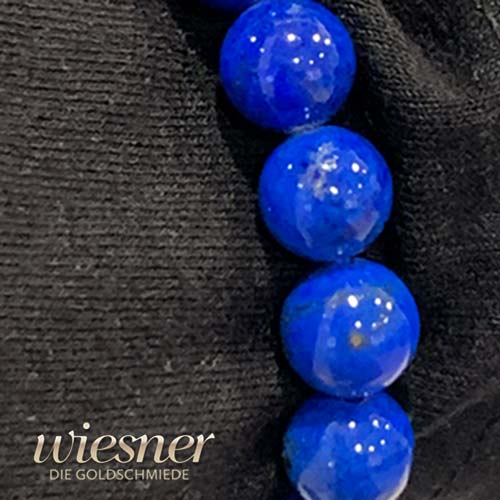
Turquoise:
The fashionable stone of the Biedermeier period is enjoying great popularity again today thanks to its fashionable color. Turquoise means Turkish stone, its trade route used to lead through Turkey to Europe, which is how the name came about. Stones in a pure blue color are very rare; turquoise is usually interspersed with brown to black veins. The best-known and most important places where turquoise is found include Nishapur in Iran, where the best quality can be found, as well as in Afghanistan, Argentina, Australia and Brazil. Turquoise is a porous stone and therefore sensitive to pressure and impact. Soaps, cosmetics and chemicals should also be kept away from it. For this reason, a turquoise ring should always be removed when washing your hands. It is also not color-fast, high heat, but also the sweat of the skin can lead to color changes.
Tourmaline:
The term tourmaline comes from the Sinhalese turmali and means stone with mixed colors. The main tourmaline deposits are found in Brazil, Madagascar, Sri Lanka and Russia. Tourmalines have also been found in Europe, for example on the island of Elba or in Ticino in Switzerland. The different colors give the tourmalines their names.
The following is a beautiful example of the many colors of tourmaline in a bracelet
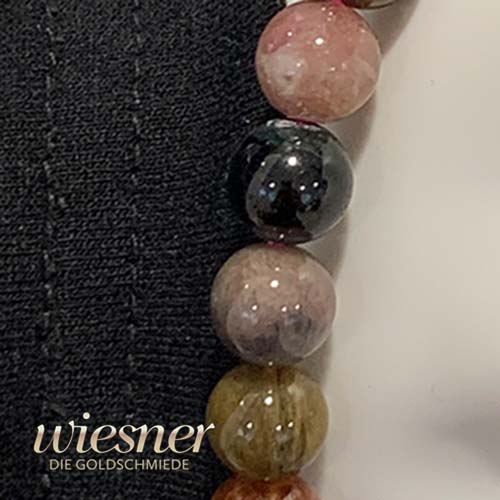
Vredelite: green tourmaline, the color ranges from light green to dark green to blue-green. Rubellite: pink to red tourmaline, sometimes with a tinge of violet. Chrome tourmaline: from deep green to emerald green, which can lead to confusion with emerald. Indigolite: from light blue to dark blue. Crystal cross-sections are particularly popular; they have several colors in cross-section. The color combinations red and green are very common. Fiber tourmalines have tiny hollow channels parallel to the longitudinal axis of the crystal; when cut into cabochons, they show a migrating shimmer of light, similar to the tiger's eye. A good distinguishing feature of tourmaline is its dichorism, which means that several colors appear when the stone is turned. The stone is light green towards the transverse axis and dark green towards the longitudinal axis.
Ruby:
Like the sapphire, the ruby belongs to the corundum group. It is the hardest gemstone after the diamond with a hardness of 9 according to Mohs. It got its name from its red color (lat. Rubens). Pigeon's blood rubies are very popular, they have a very pure red with a slight tinge of blue. The ruby owes its red color to an admixture of chromium oxide. Stones with inferior color quality are often burned to achieve better colors. Rubies are rarely found without inclusions, but this does not mean a reduction in quality, but proof of authenticity. The largest ruby deposits are found in Burma, Thailand, Sri Lanka and Tanzania. Good quality rubies have also been found in Kenya for some years now. The ruby on which a special light phenomenon can be seen is particularly valuable as it is very rare. A six-pointed star made up of lines of light appears to hover above this stone and moves across it when it is moved. This opaque ruby shows a phenomenon known as asterism, which is caused by embedded rutile needles. The star ruby is cut half round in a cabochon cut. The ruby is one of the most expensive gemstones, as large rubies are rarer than comparable diamonds. Some of the most famous stones are the Edward ruby with 167 ct, the Reeves star ruby with 138.7 ct or the peace ruby with 43 ct, which owes its name to the time in which it was found, at the end of the First World War in 1919. Many other rubies can be found in the coronation insignia or in the jewelry of royal houses.
Jade:
Jade has been known in China for 8000 years. As jade is very tough, it used to be a sought-after raw material for weapons. It was not until 2000 years ago that jade was incorporated into the cult of the gods in China and processed into mystical symbols. Buddhas are still carved from jade today. In the 19th century, a Frenchman discovered that the term jade refers to two different minerals, namely jadeite and nephrite. However, as it is relatively difficult to distinguish between these two minerals, this may be the reason for the generic term jade. Jade is not only used to make jewelry, but also very often for craft items such as vases and bowls. Jade is mainly found in China, Burma, Australia and Brazil.
Garnet:
Garnet varies greatly in terms of its specific weight, hardness and light refraction. Some varieties have their own names. The best known is the red garnet, the pyrope, whose most important deposit used to be in Bohemia. Today, the most valuable stones come from South Africa (these are sometimes incorrectly referred to as caprubies), Madagascar and Australia. Almandine is dark red, almost violet, while hessonite tends towards brown-red. Rhodolite is a pink to crimson garnet from South Africa and Tanzania. The emerald green demantoid comes from the Urals and is characterized by its high light refraction. It is also found in gemstone quality in the Congo. Until a few years ago, the grossular was only known as an opaque, gooseberry-green stone. The green translucent variety found in Tanzania was initially known as chrome grossular and is now known as tsavorite (after Lake Tsavor near where it was found)
Precious beryl:
This term covers the color varieties that are not called aquamarine or emerald. The best known of these are golden beryl, heliodor and morganite. Golden beryl: The color of this yellow beryl varies between lemon yellow and golden yellow. It rarely shows inclusions. This stone can be decolorized at 250°C. The most important places where it is found are Sri Lanka and South West Africa. Heliodor: This is the name given to the light yellow-green beryl. The name comes from the Greek and means the gift of the sun. heliodor was discovered in South West Africa in 1910, but stones of the same color were already known from Brazil. Morganite: Morganite is a pale pink to violet-colored beryl, also known as rosy beryl. It was named after the mineral collector J. P. Morgan. Stones with inferior color quality can be improved by firing at over 400°C. The main deposits are in Brazil, Madagascar, southwest Africa and Afghanistan. The precious beryls have a wonderful vitreous luster and are resistant to household cleaning agents. The most common cut is the staircase cut.
Carnelian - symbolism and possible effects
- Stamina and courage
- walking the path to success
- Recognizing and solving difficulties
- Bringing projects to a successful conclusion
- Strengthening cooperation
- Helpfulness and idealism
- Focusing on the community alongside personal success
Carnelian - Where does its name come from?
The origin is not entirely certain. The name carnelian, which can be written with a "C" or a "K", comes either from the Latin carneolus and is synonymous with flesh-colored, or from the Latin term "cornum", which stands for cornelian cherry.
Carnelian has brownish as well as yellowish and orange hues. A beautiful example of this is the carnelian bangle in our store. Named after the city of Sardis in Asia Minor, the brownish and orange-colored carnelian was also known as sardius in ancient times. For this reason, carnelian is still occasionally referred to as sardius today.
Carnelian from a mineralogical perspective
- Minerals: Quartz, as a variety of chalcedony
- Chemical: SiO2, silicon oxide with iron inclusions
- Formation: primary
- Mohs hardness: 6.7 - 7
- Colors: given by iron, yellowish, orange, brown, reddish brown
- Locations are: Botswana, India, Uruguay, Australia, Germany, Russia, India, Madagascar, Namibia
How is carnelian formed in nature?
Carnelian was and is formed in volcanic rock by the penetration of hydrous silica into the rock. The iron oxides absorbed in the process later, after solidification, give rise to the wonderful colors of carnelian.
Carnelian or sardine - history and myths
Johann Wolfgang von Goethe, who also dealt with stones and minerals in his works, formulated the verse: "Talisman made of carnelian, to the faithful it brings luck and good fortune". Suras are often carved in carnelian in Muslim culture. Carnelian is still a very popular material for signet rings today. Carnelian burial objects have also been found in ancient Egyptian tombs, suggesting that it was regarded as a protective stone for the deceased. Small ornamental figures and statues are still carved from the soft carnelian today.
Carnelian - chakras and astrology
The colors of carnelian, namely red and orange, are assigned to the second chakra. This stands for the themes of vitality and energy. The themes of relationships, encounters, creativity and affection are also attributed to the second chakra. In astrology, carnelian is assigned to the zodiac signs Aries and Cancer.
Carnelian is often burned during processing.
Carnelian, which is only a few centimetres in size in nature, usually has an inconspicuous yellow-brownish color. For this reason, many carnelians are heated to create a more attractive and decorative color by converting iron hydroxide into iron oxide. We mark these pieces of carnelian jewelry made from burnt gemstone with "burnt".
Coral:
Coral is formed by small polyps in the sea. The stick is grown with a broad base on the seabed, on rocks or on older coral sticks. With a height of up to 40 cm and an average weight of 10 kg, some coral sticks have a trunk diameter of 6 cm. The most important coral deposits are on the coasts of the western Mediterranean countries. Corresponding to their main occurrence, the color and quality names originate from the Italian language. The best known color name is probably pelle d'angelo - angel skin. This coral is a pale pink color with delicate reddish spots and is very popular in jewelry processing. As the coral is very soft, it is sensitive to heat and acids, and coral jewelry should also be removed when bathing or showering. Before the coral can be processed into jewelry, it must first be cleaned of the carbonic acid lime with which it is usually coated. The cleaned coral sticks are sawn, cut and polished, and holes are drilled for chains of sticks or for attaching to brooches in a similar way to the gemstone industry. Thicker pieces of branch are mainly processed into beads.
Rose quartz - history and mythology
Rose quartz was dedicated to Cupid, the god of love, in Roman mythology. In ancient Greece, Eros was known and rose quartz was associated with him. In both cultures, people made and wore amulets, or as we would say today, necklaces and pendants, with rose quartz. Harmony, love and fertility, even sexuality, were said to be favorably influenced. Rose quartz, which was also mined in the Bohemian Forest at this time, was also a much-loved gemstone in the Middle Ages. rose quartz was believed to have a beneficial effect on "love magic", alleviation of heart complaints and women's ailments. Even today, it is still very popular among lovers and for all matters relating to closeness and affection. It is often chosen in a cut and polished heart shape and given as a gift. For example as a rose quartz pendant or rose quartz necklace. Below is also a small excerpt from a rose quartz bracelet from our collection.
Rose quartz as a "wellness stone"
Rose quartz is said to stimulate blood circulation, especially in tired and relaxed skin. Rose quartz massage beads and massage rollers are often used for sensual partner massages, but also for normal wellness massages. Workplaces, living rooms and bedrooms can be harmoniously influenced with polished or raw rose quartz. Some people also use rose quartz for their meditations by creating a circle around themselves with the gemstones. In all these areas of application, the individual must and can make their own experiences.
Rose quartz as a gemstone
As a gemstone, rose quartz, with its pleasant color, is not only a beautiful sight, but can also be worn for a long time without hesitation, with or without skin contact. As a rose quartz pendant or necklace, for example.
Rose quartz takes its name from its pink color. It is usually processed into pure stone necklaces; its very small rutile needles create a six-pointed star in a cabochon cut. These stones are then made into pendants or rings. Only very clear stones are also cut into facets. Rose quartz can be found in Brazil, Madagascar, India and Sri Lanka, among other places.
Rose quartz in astrology
Astrologically, rose quartz is assigned to the zodiac sign of Taurus and Cancer. Its powers unfold best in the 4th chakra, the heart chakra.
Schorl or black tourmaline - symbolism and effect
- Schorl is often used as a collector's item, but also to suppress interference in electrical devices.
- Both energy overflow and energy deficiency can be harmoniously influenced by schorl.
- Harmonizing in case of great stress
- Helps to adopt a calm and relaxed attitude.
- Schorl is often used in the home and workplace and on desks to harmonize negative electronic influences.
- Promotes perception and creativity
- Recognizing larger contexts and controlling developments, as well as bringing them to a positive conclusion.
Schorl from a mineralogical perspective:
- Minerals: Ring silicate of the tourmaline family
- Chemical: NaFe3Al6[(OH,F)4/BO3)3/Si6O18]
- Formation: in magma
- Mohs hardness: 7 - 7.5
- Colors: black
- glassy luster
- no fissility
- Locations are: Madagascar, Namibia, Pakistan, USA and Brazil
Where does schorl get its name from?
The name of schorl, or rather its origin, cannot be proven beyond doubt. It is assumed that it was named after the place where it was first found, namely the Saxon town of Zschorlau, or that the town was named after the black tourmaline, schorl.
Schorl is very crumbly in its original state
As schorl is very friable in its natural state, it is stabilized to produce larger pieces. For this purpose, the schorl is impregnated with a resin, which gives it a workable and usable stability after hardening.
Schorl in astrology
Astrology assigns schorl to the zodiac sign Capricorn, which can gain flexibility as a result. It is also assigned to the root chakra, but also to the other lower chakras 1 - 4.
Zircon:
Zircon is created by combining the metals silicon and zirconium with oxygen. It has the strongest refraction of light after diamonds. Zircon is found in Ceylon, Australia, Siam and South Africa. The colors of zircon range from colorless, yellow, yellow-red, red, blue, light brown to brown. Colorless, yellow, light brown or brown stones are usually used for jewelry. The color of zircon can be changed by firing or radium irradiation. It often happens that zircons that have been given a different color by irradiation change it again when heated or in daylight. Colorless zircon is often confused with rock crystal.
Why gemstone jewelry is a special gift
Every gemstone holds its own magic. Formed in the depths of the earth, they carry thousands of years of secrets, stories and energy. Our selection of gemstone jewelry reflects these deep connections to nature and human history.
Sustainability and quality: We focus on sustainable sourcing and high-quality workmanship in our selection of gemstone necklaces. This is the only way to bring out the true beauty of these natural treasures.
From special occasions to everyday joy: Whether you are looking for a special gift or want to enhance your everyday outfit - gemstone jewelry is versatile and always an eye-catcher.
Care tips for your gemstone jewelry: We recommend regular care to ensure that your piece of jewelry shines and sparkles for a long time. Some gemstones require special attention to preserve their color and shine. You can find valuable tips and tricks for caring for your jewelry in our advice section.
Find your gemstone: From powerful rubies and calming rose quartz to dazzling opals - in our "Gemstone jewelry" category, you will find a wide range of stones to suit your personality and style.

